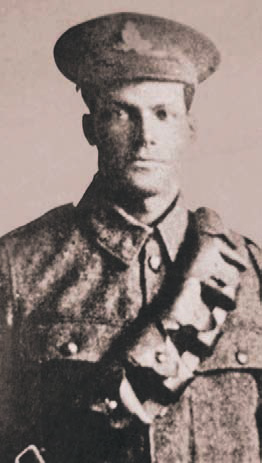Gnr
Douglas Roy Manley
Information about birth
|
Date of birth: 25/10/1895 |
|
Place of birth: Porus, Manchester, Jamaica |
General information
|
Last known residence: 48 Cathcart Road, Earls Court, Middlesex, England, United Kingdom |
|
Profession: Student |
Army information
|
Country: England, United Kingdom |
|
Force: British Expeditionary Force |
|
Rank: Gunner |
|
Service number: 41804 |
|
Enlistment date: 21/09/1915 |
|
Enlistment place: Deptford, Kent, England, United Kingdom |
|
Units: — Royal Field Artillery, "D" Bty. 174th Bde. (Last known unit) |
Information about death
|
Date of death: 26/07/1917 |
|
Place of death: Wilson Farm, Sint-Jan, Belgium |
|
Cause of death: Killed in action (K.I.A.) |
|
Age: 21 |
Cemetery
|
Poperinghe New Military Cemetery Plot: II Row: E Grave: 41 |
Distinctions and medals 2
|
British War Medal Medal |
|
Victory Medal Medal |
Points of interest 4
| #1 | Place of birth | ||
| #2 | Last known residence | ||
| #3 | Enlistment place | ||
| #4 | Place of death (approximate) |
My story
Douglas Roy Manley and his brother Norman were born into an influential Jamaican family, of mixed African, Caribbean and Irish descent. By 1909, their parents had died and the brothers moved to England, where Roy attended a public school in Essex. He was good at sports, cricket and running, and was a 19-year-old student when he enlisted. Despite being wealthy and well-educated, Roy was refused officer training. Both brothers then joined the Royal Field Artillery in Deptford, a working-class area in south London, in September 1915. Norman was appointed corporal and faced racial prejudice as a "coloured" N.C.O. He gave up his rank and, like his brother, returned to the rank of gunner. They were part of "D" Bty, 174th Brigade Royal Field Artillery, 39th Division.
Roy and Norman were gunners, brought guns into position to fire and took up new positions. After their deployment to the Somme in 1916, they moved to the Ypres Salient in mid-1917, where they supported the 39th Division's front in June and July, between St Julien and the Ypres-Iser Canal. By then, Roy had been wounded in February 1917. On 26 July 1917, as they were setting up artillery positions, their battery was caught in a German shell storm. This was possibly near Wilson Farm, where the battery stood on 30 July 1917. In moments, half the men were wounded or dead. According to Norman, Roy was carrying a wounded man on his back, who turned out to be dead, when he too was killed by shrapnel in the heart. Gunner Douglas Roy Manley was buried in Poperinghe New Military Cemetery, where he is still remembered today.
Norman stated that after losing his brother, he would be lonely for the rest of the war. After the war, he returned to Jamaica. He became one of the island's leading lawyers and founded the People's National Party in 1938. Norman Manley became Prime Minister from 1955 to 1959 and Prime Minister from 1959 to 1962 and led Jamaica to independence in 1962. In 1969, shortly after his death, he was given the title of National Hero.
Roy and Norman were gunners, brought guns into position to fire and took up new positions. After their deployment to the Somme in 1916, they moved to the Ypres Salient in mid-1917, where they supported the 39th Division's front in June and July, between St Julien and the Ypres-Iser Canal. By then, Roy had been wounded in February 1917. On 26 July 1917, as they were setting up artillery positions, their battery was caught in a German shell storm. This was possibly near Wilson Farm, where the battery stood on 30 July 1917. In moments, half the men were wounded or dead. According to Norman, Roy was carrying a wounded man on his back, who turned out to be dead, when he too was killed by shrapnel in the heart. Gunner Douglas Roy Manley was buried in Poperinghe New Military Cemetery, where he is still remembered today.
Norman stated that after losing his brother, he would be lonely for the rest of the war. After the war, he returned to Jamaica. He became one of the island's leading lawyers and founded the People's National Party in 1938. Norman Manley became Prime Minister from 1955 to 1959 and Prime Minister from 1959 to 1962 and led Jamaica to independence in 1962. In 1969, shortly after his death, he was given the title of National Hero.
Sources 4
|
Bourne S., Black Poppies: Britain's Black Community and the Great War (Stroud, The History Press, 2014) 56-61. Sources used |
|
Dendooven D., "Lads of the West": Het British West Indies Regiment van de Caraïben naar het westelijk front en terug, 1915-1919 (Ieper, In Flanders Fields Museum, 2023) 85-87. Sources used |
|
Headquarters Branches and Services: General Staff. (The National Archives, KEW (TNA), WO 95/2566/5). https://www.nationalarchives.gov.uk/ Sources used |
|
War Office: Soldiers' Documents (The National Archives, Kew (TNA) WO363). https://www.nationalarchives.gov.uk/ Sources used |
More information 3
|
Commonwealth War Graves Commission Database https://www.cwgc.org/find-records/find-war-dead/casualty-details/139395 |
|
Lives of the First World War (Imperial War Museum) https://livesofthefirstworldwar.iwm.org.uk/lifestory/2901166 |
|
Namenlijst (In Flanders Fields Museum) https://namenlijst.org/publicsearch/#/person/_id=27960853-c764-40b2-88bc-0acaff8f8439 |
